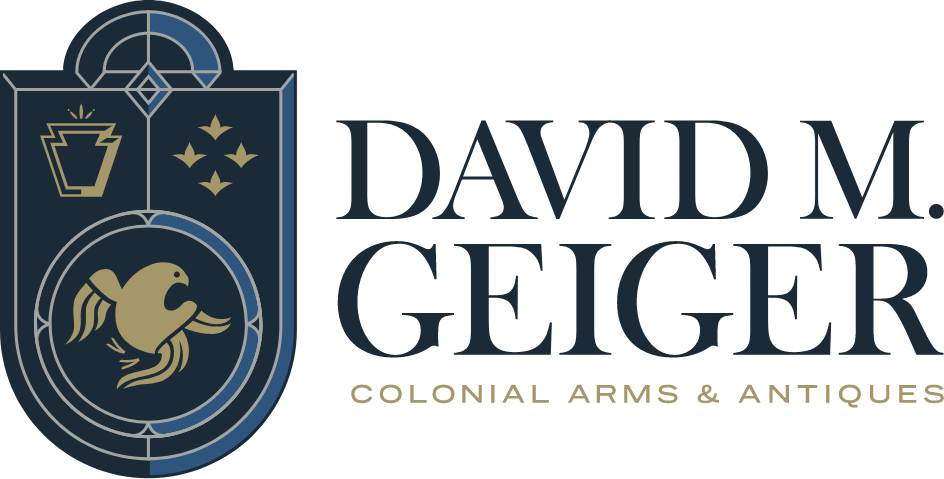
Appraisals
An 18th century firearm is much more than just a weapon from a bygone age. It is a piece of art, an example of stellar craftsmanship, and — perhaps most importantly — a piece of American history. When you hold one of these antiques, you are holding something that witnessed the birth of a nation (and might have even played a role in it); this is the irresistible draw that pulls collectors toward these beautiful pieces.
There is true excitement and joy that comes from owning a piece of history like an antique firearm. But on the other hand, there is disappointment that comes with finding out that the colonial firearm you purchased wasn’t an authentic antique. This is why it’s critically important to have your antiques appraised by a credible and trustworthy expert.
David M. Geiger IS that expert. A lifelong history enthusiast and fourth-generation antiques dealer, David can easily spot the subtle differences between reproduction weapons and the genuine article. With his keen eye, expert knowledge, and renowned integrity, you can be certain that his appraisal of your item will be thorough, informative, and accurate.

Who Needs an Appraisal?
Antiques collectors should always be encouraged to appraise their items, as it can help them understand the value of their collections and guarantee their authenticity. However, most people who get their antiques appraised fall into one of the following categories:

Potential Buyers and Sellers
These individuals either have an antique they want to unload or one they are looking to purchase — but they want to make sure they get a fair price. An antique’s value can fluctuate due to many factors, including the market rates, the condition of the item, and whether is has any restoration or alterations.
Because of the volatility in the antiques market, it’s wise for buyers and sellers to have any item appraised before they complete any transaction. This will give everyone involved an accurate valuation for the item at that specific moment, which allows both buyer and seller to make the smartest decisions possible for that item at that time.

Collectors Seeking Insurance
If you are a seasoned antiques collector, you likely know how important it is to insure your collection. Your antiques are precious valuables that mean a lot to you — and unlike many other items in your home, they cannot be easily replaced if they are damaged, lost, or stolen.
But in order for collectors to get insurance for their antiques, they must have an accurate appraisal for their insurers. An updated appraisal can help you gain adequate coverage for those valuable items, ultimately granting you peace of mind and protection for the collection you’ve so lovingly built and cared for.

Novices Seeking Information
Another common group looking to appraise their items is the antique novice. Perhaps this person inherited an antique from a loved one; perhaps they found something interesting at a local auction or estate sale. But, however, they happened to procure the antique, they now need to find out just what they have (and how much it’s worth).
The trouble with antiques is that they are often unique and rare, and many people can’t tell the difference between the real and the fake. In many cases, these novice individuals discover that they’re holding a reproduction and not a genuine antique. But when an item does turn out to be authentic — those are the stories you read about a $5 garage sale find actually being worth millions.
The Appraisal Process
As you can see, an appraisal can help you determine how best to take care of your antique — how much to buy or sell it for, how much to insure it for, and even whether it’s worth caring for at all. But what does the appraisal process look like? Here is a quick example of a typical appraisal.

Initial
Contact
If they are contacting the appraiser via email, the collector may also include some photos of the item for an initial look. This is an excellent way to rule out obvious reproductions without taking up too much of the appraiser or client’s time. However, if those first photos point to a possible genuine antique, the appraiser will schedule an in-person consultation.

On Site
Inspection
During this consultation, the appraiser will examine the item’s make and condition to determine its worth. He or she might ask you some questions about the antique to learn more about how you got it. If you have any documentation about the item, it will be useful to bring it to this meeting, as the appraiser can use it to glean a greater understanding of the item’s value. Remember, this step is critical to receive an accurate assessment, so it’s important to be as honest and forthcoming as possible.

Authentication
& Reporting
Collectors can use these appraisals to establish both authenticity and value for their antiques. Additionally, the information in these records can give you an interesting glimpse into the history behind your item. However, it is important to note that an appraisal — more specifically, a valuation — is not concrete. Long-term collectors might want to have their items reappraised every few years, as changing markets can mean big changes for the value of your collection.
